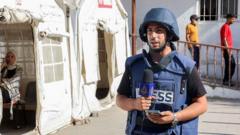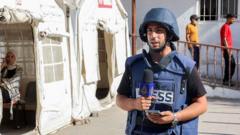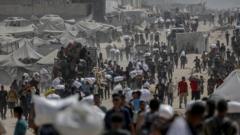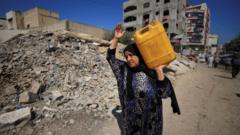Amidst the devastation, the presence of toxic asbestos fibers poses long-term public health risks that could linger for decades.
**The Hidden Danger: Asbestos Risk in Gaza's War-Damaged Rubble**
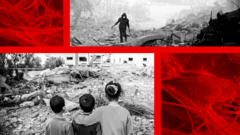
**The Hidden Danger: Asbestos Risk in Gaza's War-Damaged Rubble**
As military conflict ravages Gaza, experts warn of looming health crises due to asbestos contamination in its rubble.
In the aftermath of the relentless military actions in Gaza, an insidious threat has emerged: asbestos contamination in the rubble left behind. This once widely used building material, now banned in many regions due to its carcinogenic properties, poses significant risks as its fibers, imperceptible to the naked eye, can become airborne when disturbed. These toxic fibers, when inhaled, can embed themselves in the lungs and lead to serious illnesses, including cancer, over time.
According to the United Nations Environment Programme (UNEP), it is estimated that approximately 2.3 million tons of debris in Gaza may harbor asbestos, particularly in the roofing materials of the refugee camps established after the 1948-49 Arab-Israeli conflict. Professor Bill Cookson, a leading authority on mesothelioma at the National Centre for Mesothelioma Research in London, underscores the gravity of the situation, describing the region as a "very, very toxic environment." The long-term health effects, especially for children, could be catastrophic, extending decades into the future.
Medical professionals and researchers emphasize that even minor exposure to asbestos can trigger deadly conditions like mesothelioma and asbestosis, which manifest years later. Dr. Ryan Hoy notes that the minuscule size of asbestos particles makes them dangerously easy to inhale, especially in densely populated areas such as Gaza, where about 2.1 million residents live in a space just a quarter the size of London.
Amidst the crisis, however, most Gazans remain preoccupied with more immediate dangers—namely, the threat of bombings. NGOs working in the territory highlight a troubling lack of awareness regarding the long-term risks posed by the debris and dust, as survival takes precedence over potential health complications. Prior surveys have already detected various types of asbestos in the rubble from previous conflicts, pointing to a persistent risk that can be exacerbated by ongoing military actions.
With efforts now underway to reconstruct Gaza, the UN warns that improperly managed debris removal could elevate the risk of asbestos exposure. The plans to rebuild must be carefully executed to prevent further harming the population that has already endured so much trauma. As international dialogues about reconstruction strategies intensify, health experts continue to stress the need for comprehensive approaches that account for the potential health crises stemming from a long-ignored enemy: asbestos. Without adequate awareness and preventive measures, the toll from this silent killer may soon rival that of the violence itself.
According to the United Nations Environment Programme (UNEP), it is estimated that approximately 2.3 million tons of debris in Gaza may harbor asbestos, particularly in the roofing materials of the refugee camps established after the 1948-49 Arab-Israeli conflict. Professor Bill Cookson, a leading authority on mesothelioma at the National Centre for Mesothelioma Research in London, underscores the gravity of the situation, describing the region as a "very, very toxic environment." The long-term health effects, especially for children, could be catastrophic, extending decades into the future.
Medical professionals and researchers emphasize that even minor exposure to asbestos can trigger deadly conditions like mesothelioma and asbestosis, which manifest years later. Dr. Ryan Hoy notes that the minuscule size of asbestos particles makes them dangerously easy to inhale, especially in densely populated areas such as Gaza, where about 2.1 million residents live in a space just a quarter the size of London.
Amidst the crisis, however, most Gazans remain preoccupied with more immediate dangers—namely, the threat of bombings. NGOs working in the territory highlight a troubling lack of awareness regarding the long-term risks posed by the debris and dust, as survival takes precedence over potential health complications. Prior surveys have already detected various types of asbestos in the rubble from previous conflicts, pointing to a persistent risk that can be exacerbated by ongoing military actions.
With efforts now underway to reconstruct Gaza, the UN warns that improperly managed debris removal could elevate the risk of asbestos exposure. The plans to rebuild must be carefully executed to prevent further harming the population that has already endured so much trauma. As international dialogues about reconstruction strategies intensify, health experts continue to stress the need for comprehensive approaches that account for the potential health crises stemming from a long-ignored enemy: asbestos. Without adequate awareness and preventive measures, the toll from this silent killer may soon rival that of the violence itself.






